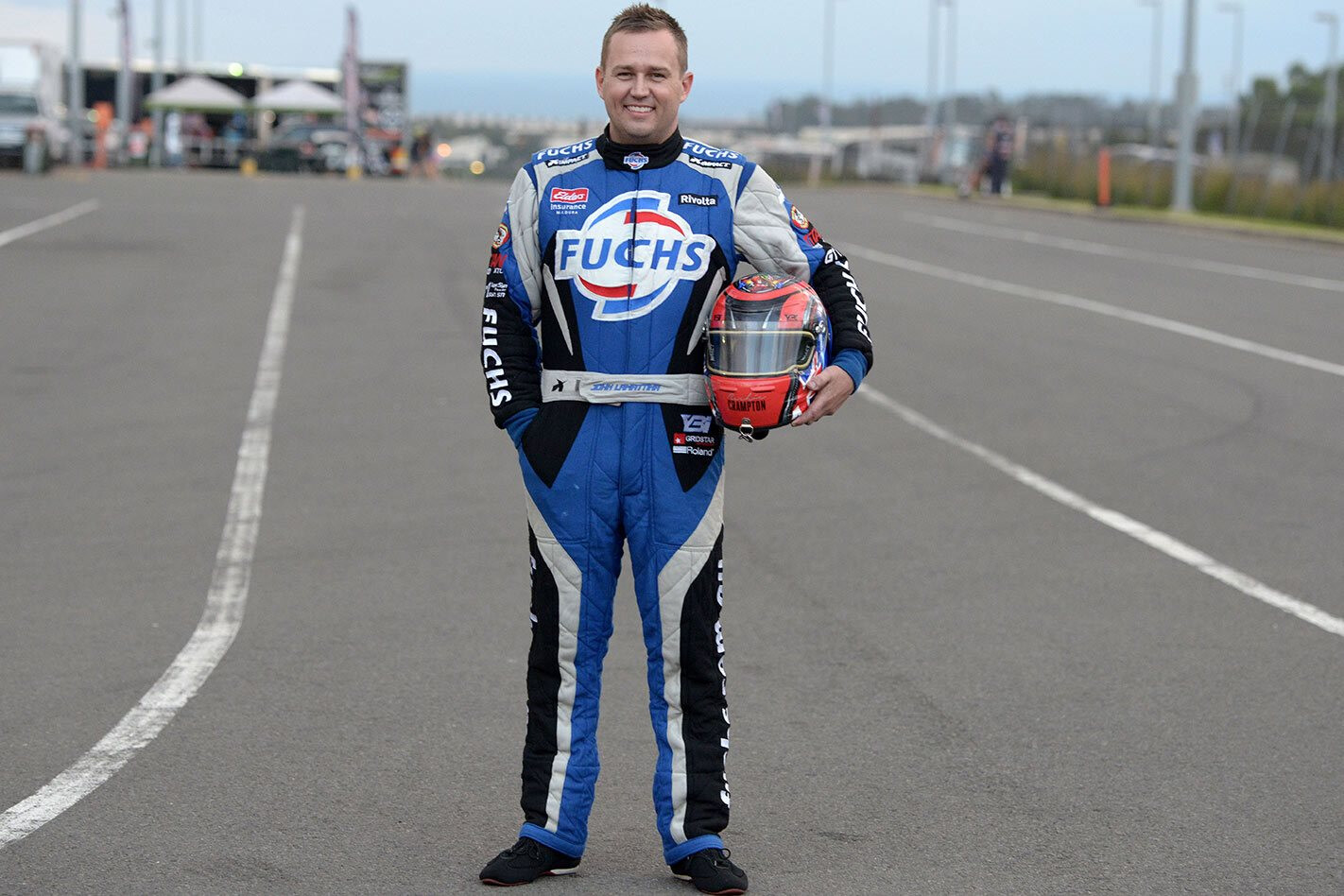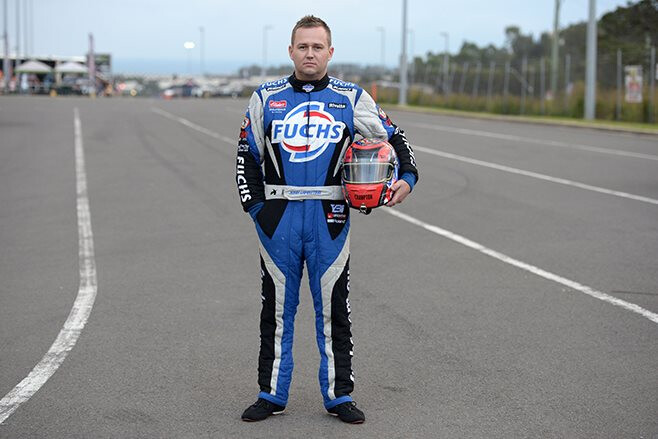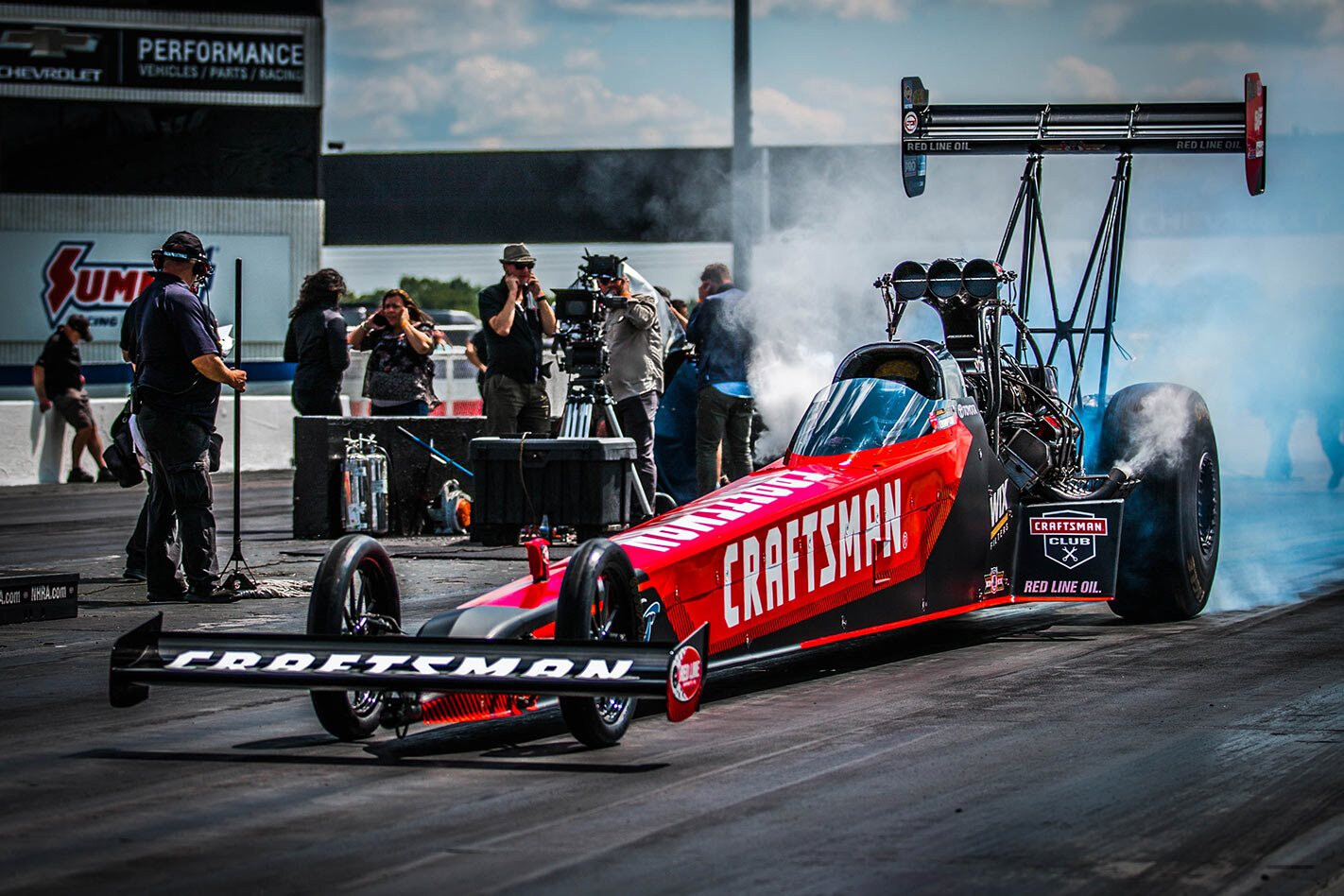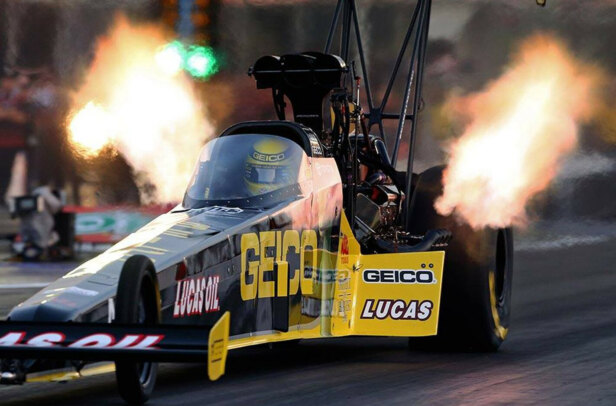Aussie born and bred NHRA Top Fuel star chats about his career and his epic Drag Week build
This article on Richie Crampton was originally published in the July 2017 issue of Street Machine
PAROCHIAL Australians will have another car to barrack for at Hot Rod Drag Week this September, with Adelaide-born, Indianapolis-based Richie Crampton throwing his helmet in the ring with a mangy-looking ’57 Chevy longroof.
The 36-year-old race car builder-turned-Top Fuel driver lost his seat in the NHRA ranks when Morgan Lucas Racing made the decision to cease racing Top Fuel at the end of last year. And while he hasn’t managed to land another full-time ride, he still works turning spanners for the organisation at Lucas Oil Race Fabrication in Brownsburg, Indiana, where he’s currently building his Hot Rod Drag Week weapon.
Richie recently returned to Australia to race Top Fuel on home soil for the first time in the Lamattina Racing car at the Nitro Thunder event in Sydney. SM caught up with him in the pits on race day to discuss his Super Sedan racing roots, his NHRA career path and his goals for Drag Week in September.
What was the first car you owned?
My first car was the FC Holden station wagon that me and my dad ended up creating a race car out of. I got that when I was 15. It started out with a carburetted motor on pump gas and we ended up putting a 14/71 supercharger on it and running it on methanol. We did a lot of the work at home in the shed; me and my dad just figured out how to do it with the help of some friends and really learned a lot and had a lot of fun.
What tracks did you race at?
AIR in Adelaide was my home track, but I raced it all over. We competed at Calder Park, the Winternationals at Willowbank, and even went to the first Westernationals at Kwinana in Perth when that opened.
Then at some point you relocated to Sydney?
I stopped racing around 2001 when AIR sort of closed down and they stopped running regular events there. I still wanted to be involved in racing and I was lucky enough to move to Sydney and become one of not very many full-time Top Fuel mechanics, working at Rocket for Graeme Cowin. Then when the Cowins decided they wanted to go to the US and compete in the NHRA, they took me over as a crew member, and that kind of opened the door to what I eventually did over there. If it weren’t for the Cowins taking me over there in 2004, I don’t know how I would have made that jump.
It’s a rare feat for a foreigner to make the transition from mechanic to Top Fuel driver in the NHRA – there must have been a bit of ‘right place, right time’ happening for you in the States?
Yes. When the Cowin family decided to go back to Australia in 2005 I was fortunate enough to have met a guy called Richard Hogan who was assembling a team at Don Schumacher Racing. Melanie Troxel drove that car. Then 18 months later we transplanted as an entire team to Morgan Lucas Racing when they added a second car, and basically I worked for Lucas for seven years as a crew member. [Owner/driver] Morgan Lucas knew how much I had left behind in Australia to come and do it. I’d beat on him a little bit and they finally broke and allowed me to jump in the driver’s seat in 2013, and the rest is history.
Having enjoyed some NHRA Top Fuel success, including the US Nationals in 2014, you found yourself without a drive last year – how did you take that setback?
Last November when I got the news that Morgan Lucas Racing as an organisation was shutting the doors, it was a pretty big blow. But fortunately they asked if I’d continue to work at Lucas Oil Fabrication, so I’m still hands-on building race cars and working as a fabricator for them. So it’s not all bad. It’s very disappointing that we’re not racing competitively anymore, but I had fun while it lasted.
And the upside is you now have time to build a car for Drag Week.
My ’57 Chevy wagon Drag Week car came about just through the ability for me to do it this year for the first time ever, now that I’m not racing all over the country all year long. Drag Week has always appealed to me – you’ve got to build your car to be fast at the track but reliable on the road as well. You’ve got to know your race car inside and out and be able to fix anything on the side of the highway. From what I understand it’s five days of torture. It seems to be a really exciting challenge.
What grave did you dig the ’57 wagon out of?
I was looking for a car and the only one that came up in Indiana on Craigslist was this ’57 Chevy wagon. It was in South Bend, which is up by the Michigan border. [NHRA Funny Car driver] Jonnie Lindberg – he’s a real good friend and a really talented fabricator – he and I went and picked it up. It was below zero, we froze our butts off, but we got it on the trailer and got it back home and waited for the snow to melt off it so we could see what we’d bought. Then we got to work on cutting the floor out and building a full-tube chassis.
Why leave it with the ‘patina’ look?
I wasn’t specially setting out to build something that looks like you need a tetanus shot to go near it. But for me, the time, the expense of painting it, all those issues are just going to hold me back from really focussing on the power and reliability things that I want to focus on. I personally like that look. I know there’s a lot of people wearing that style out right now and it’s kind of getting old, but there’s just something cool about that look, like you just dragged something out of a paddock and you got it to go fast. So that’s my MO with the car.
Can you explain your decision to retain all the steel and chrome?
Keeping as much of the original car is the key. I don’t want to put fibreglass panels on it if I don’t have to. Y’know, obviously you want to make the race car as light as you can for performance reasons, but there’s something about the old rusty look of that car and I think it just adds a little more cool factor to leave it as-is. I’m probably leaving a little on the table by doing things that way, but I just think this is a fun way to do it.
Who has helped out with the build?
My wife Stephanie and I, we’re in this deal together. It’s coming out of our pockets, but we’re getting help from a lot of people. Jonnie Lindberg helped me in the beginning but now he’s on his full-time NHRA racing schedule. The assistant crew chief we had at Lucas, Rod Centorbi, is equally excited about Drag Week so he’s been spending a lot of nights and weekends on it with me too, so I can’t thank him enough. Obviously I’ve been fortunate enough to build the race car at Lucas Race Fabrication where we still build Top Fuel cars, so we’ve got every bit of equipment to be able to pump out nice, quality fabrication and race car work. That’s helped the speed of the build. Apart from Lucas there’s been so many great people that have also helped: Sander Engineering gave me a free set of wheels, Hoosier, Strange Engineering, JEGS, the list goes on.
Have you sorted out the powerplant yet?
That’s the next thing I need to do. It was going to be a Chevy LSX, that’s what started the project, but Lucas has a good relationship with Brodix so now I think I’m going with a Brodix iron block and BB-2 aluminium cylinder heads. It’ll have twin 76mm Garrett turbos and be running on E85.
What do you think will be the key to Drag Week success?
I think with the EFI engine management, the twin turbos are going to help the engine side of things – you can run less compression, they run cooler, they’re not as hard on parts, so I think all those things are going to help. I’ve got a suspicion that transmissions and torque converters might be another challenge, but I don’t know. I don’t really know what I’m in for, but I’m about to find out in September!
Will you be towing a box trailer, as allowed per the rules?
I thought a station wagon would have plenty of room to carry spares and other things, like a generator and compressor, but the way we’ve built it, there’s not much room back there anymore. I really don’t know how extreme I need to get and what I’m gonna need to take. I’m trying to avoid the trailer. I might lean to a roof rack, I might try to fit it all in the car, too; we’ll just see how it pans out. But I think a Griswold-style roof rack is just gonna be the icing on the cake.
Richie got his FC station wagon when he was 15 after a long love affair with Holdens. His earliest auto-related memory is of riding in his dad’s HK Premier wagon. “It was Silver Mink and had the dark red vinyl interior,” he recalls. “I always wanted to get one of those when I grew up”
After finishing school, Richie got his trade in panel beating and initially worked for his dad, Alan, at Auto Carburettor Services in Marion, SA, until his big move to Sydney to work for Cowin Family Racing in 2001
All smiles with baby daughter Emma and wife Stephanie (and let’s not forget ‘Wally’) after the big US Nationals win. This was actually the first time Emma, now three, attended one of Richie’s races 04: Richie was 17 when he first raced his Chevy-powered FC at Adelaide International Raceway. “At first it had a carburetted 502ci big-block in it and ran in the low 10s,” he says. “We ended up putting a supercharger on it and ran as quick as 7.65. At the time there was a lot of interest in Wild Bunch racing, so that was my target there”
Richie was 17 when he first raced his Chevy-powered FC at Adelaide International Raceway. “At first it had a carburetted 502ci big-block in it and ran in the low 10s,” he says. “We ended up putting a supercharger on it and ran as quick as 7.65. At the time there was a lot of interest in Wild Bunch racing, so that was my target there”
In May, Richie was in Australia to race Top Fuel on home soil for the first time at the Nitro Thunder event in Sydney. Making a cameo appearance driving the Lamattina Racing Top Fueler tuned by Aaron Hambridge, he laid down the quickest pass on race day, a 4.538@329mph, but was beaten in the final by a Rapisarda Autosport car driven by Wayne Newby
The SFI-spec 25.3B full-tube chrome-moly chassis was built by Richie and his good mate, Swedish-born two-time NHRA Top Alcohol Funny Car champ Jonnie Lindberg, and is certified to run as quick as 6.5sec
The tube chassis was built so the bodyshell could easily hook on via the rear body mounts in their stock location. “I took the body on and off a few times during the build,” Richie says. “Once I finished the wheel tubs and all the tinwork in the floor and plumbed it, it was welded down to the sill panels with the firewall welded in”
“I just want to finish all five days of racing,” Richie says. “If I can run eights and finish the week, I’ll be happy. But deep down, hell yeah, I wanna run sevens!”
“Every bit of ’57 Chevy sheet metal is going to remain – the doors, fenders, bonnet, tailgate, probably even the bumpers, as stupid as that is because they’re so frickin’ heavy,” Richie says. “It’s going to have to have plastic windows, as per [Drag Week] rules, but otherwise it will be all steel”




Comments